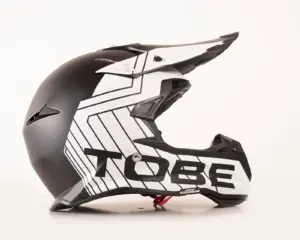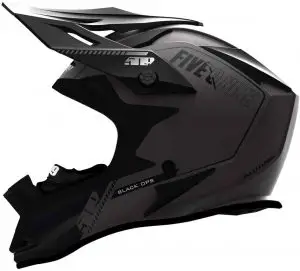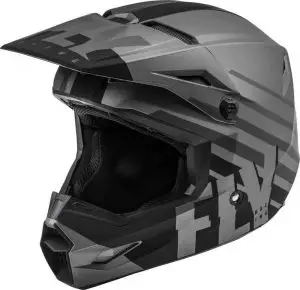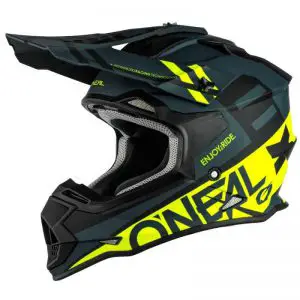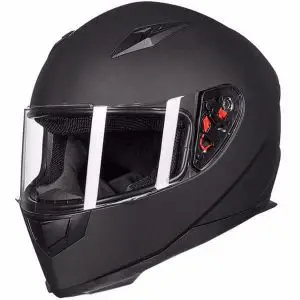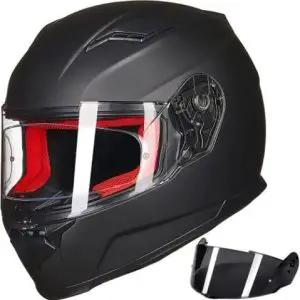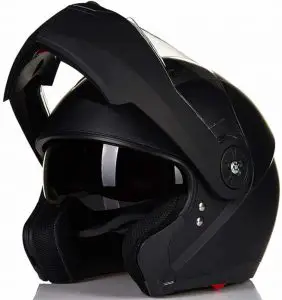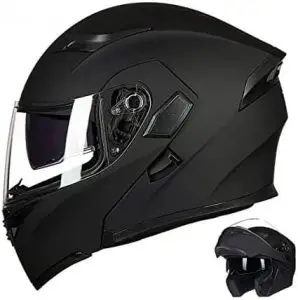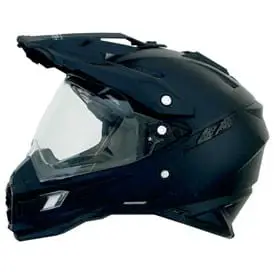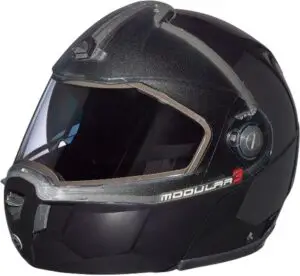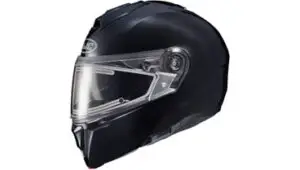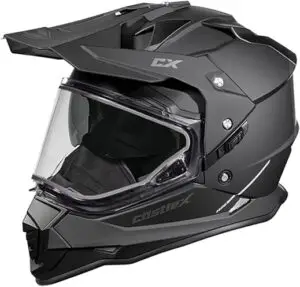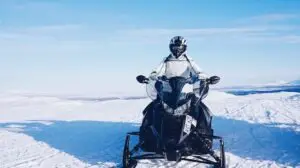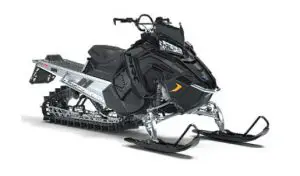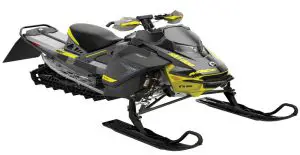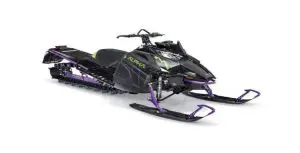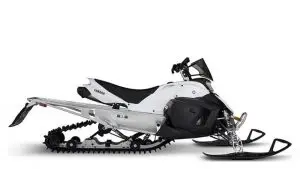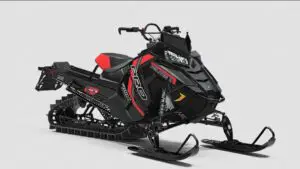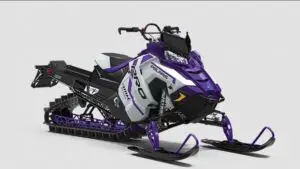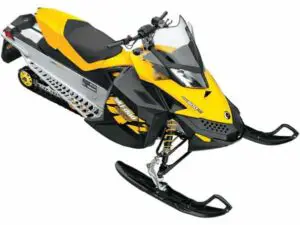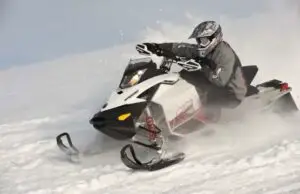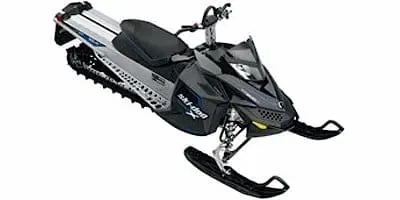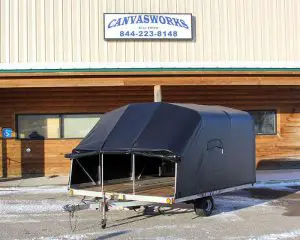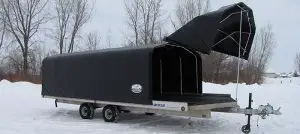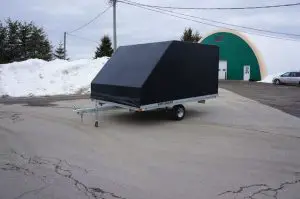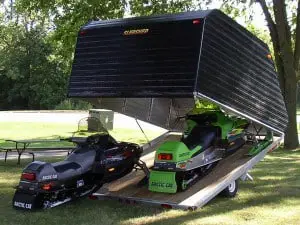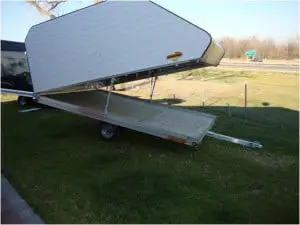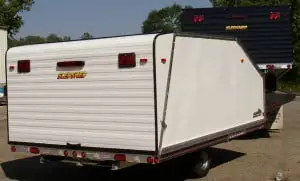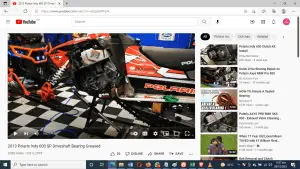The best skiing and snowboarding take place in the backcountry. These areas are more accessible by using the best snowmobile for backcountry skiing. If you have seen a Warren Miller ski movie recently, it is most likely that they reached the snow areas by either snowmobile, helicopter, or snowcat. Skiers and snowboarders head to backcountry to get away from the noise and crowds of ski resorts to get solitude and fresh air in the backcountry and to pursue their passion of finding untouched powder. The older two-stroke snowmobiles were polluting and loud. Nowadays, with the advent of more quieter and efficient four-stroke engines, these environmental footprints have been substantially reduced. The best snowmobile for backcountry skiing can be attributed to their aggressive appearance, reliable engines and their ability to climb previously unreachable terrains.
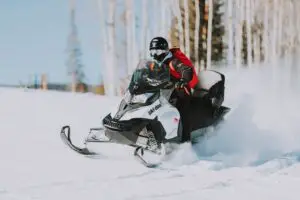
According to Snowsports Industries America, the number of people who participate in backcountry skiing has almost tripled in the last ten years. It is by far the most rapidly growing aspect of skiing. Every leading snowmobile brand manufactures backcountry gear. Let us take a look at a few of the best snowmobile for backcountry skiing by these major snowmobile brands.
Ski-Doo Summit X 850
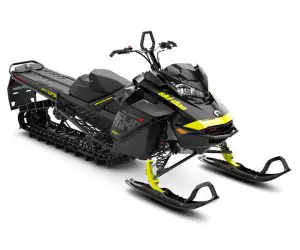
The Summit X 850 by Ski-Doo backcountry snowmobile offers a great competent combination by featuring the 4th generation platform along with 850CCE-TEC 2-stroke engine, which delivers extraordinary performance and exquisite driving experience. It comes with a track length of 154, 165, and now available in 175 inches as well. Summit X 850 features the SHOT System which stores energy, giving the rider to quickly start-up the engine after a complete stop unaccompanied by the usual weight constraint which was seen with the ordinary start-up systems saving almost 20 lbs. in this process, while also gaining from an alternate start-up system. One of the most salient features of this snowmobile is its ergonomic design which is geared according to the rider’s requirements. This Ski-Doo Summit X 850 is a perfect snowmobile for backcountry skiing and its driving experience is very intuitive with the rider feeling a sense of complicity by the machine.
Arctic Cat Alpha One
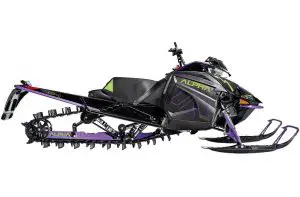
The Arctic Cat Alpha One is one of the most well balanced and easiest to ride snowmobile for backcountry skiing. It comes with single-beam rear suspension which is stable and easy to handle and works perfectly with front suspension making it one of the most responsive rider-to-chassis sleds. It has reduced vehicle weight, track inertia and track rotating mass which are all dialed into the Ascender chassis. Also, it requires less energy to turn into an aggressive rider and that too in a controlled manner. The Alpha One’s skid frame follows the principle that a deep snow skid does not require two rails. As a replacement, there is a single, rigid rail that runs down the center of the track which allows more turning flexibility from the track, better sidehilling, quicker pivots, and reduced weight, still providing all the best what a mountain backcountry snowmobile does in powder.
Polaris Pro-RMK 800
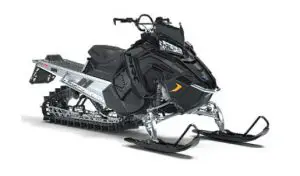
Polaris offers RMK mountain snowmobiles paired with an excellent AXYS frame to make a great backcountry snowmobile. This AXYS frame provides a good advantage to the sled by providing rigidity, making them lightweight and specifically it offers the general balance to the snowmobile making it perfect for backcountry skiing. This Pro-RMK 800 is an exceptional vehicle offered by Polaris which features a strong 800CC cleanfire 2-stroke engine and comes in wide options of track lengths like 155, 163 and 174 inches. It has a well-calibrated and adjustable suspension that is designed literally to swallow the snow. It comes in different colors as well and provides an astounding driving experience by being one of the lightest sleds in the market. A conclusion is a snowmobile that is excellent for backcountry mountain riding since its name is in fact, RMK or Rocky Mountain King.
Yamaha Sidewinder M-TX
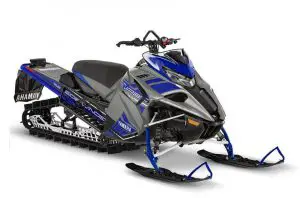
The Yamaha Sidewinder M-TX is different from other backcountry snowmobiles since it comes with a 4-stroke engine, heavier weight, and generous dimensions. Nevertheless, this vehicle rides greatly because of the combination of a 200 HP engine and a 130 lbs/ft. torque offering the necessary energy to reach the mountain peak at full force. Yamaha has been expanding its backcountry snowmobile models and arrangements to satisfy their customer needs. Additionally, it is possible to buy an aggressive 162 inches long that have 3 inches paddles, which provide you traction necessary for Sidewinder’s power to transmit on the terrain and propel the vehicle convincingly. Yamaha Sidewinder M-TX comes with remarkable mechanics that can never fail even on high altitudes. This is a noteworthy advantage over the 2-stroke engines. Yamaha snowmobiles are in an ideal situation with large amounts of snow in open terrains. However, with its heavyweight and larger size, quick maneuverability can become a tiring task in tight paths.
Polaris 600 RMK 144
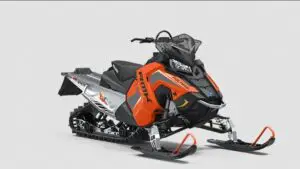
Polaris 600 RMK 144 is a suitable snowmobile for hobbyists who love on-trailing riding and backcountry skiing. Its 600 Cleanfire engine (2-cylinder, 599cc) offers powerful and reliable performance. The lightweight AXYS platform ensures accurate cornering, superior maneuverability, and precise handling, while the RMK Adjustable front and IGX 144 rear suspensions facilitate a comfortable ride. Polaris 600 RMK 144 has Gripper skis and a 15” wide and 144” long Series 4 track with 2” height for deep snow riding, making it one of the best snowmobiles for backcountry skiing. Riders will find the sled to be responsive and balanced and may ride with confidence in all conditions.
Polaris Patriot Boost RMK KHAOS MATRYX SLASH 155
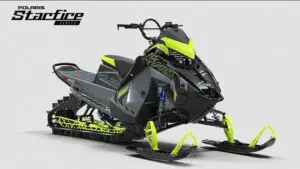
Polaris Patriot Boost RMK KHAOS MATRYX SLASH 155 is a premium sled among the best snowmobiles for backcountry skiing. Residing under its hood is an 850 Patriot Boost turbo-charged engine that yields exceptional performance in challenging conditions. It is complemented by the QuickDrive 2 drive system. Riders can choose between a 15 x 155 x 2.75” Series 8 or 15 x 155 x 3” Series 7 track to obtain superior grip on the deepest powder. Polaris Patriot Boost RMK KHAOS MATRYX SLASH 155 is based on the RMK platform and yields unmatched control and maneuverability. It is one of the best snowmobiles for backcountry skiing on mountainous terrains. Polaris Patriot Boost RMK KHAOS MATRYX SLASH 155 starts at $19,599 and is a high-end product from the brand. It will suit riders who want nothing but the best snowmobile for backountry skiing. Non-turbocharged engine options are also available.
Ski-Doo Freeride
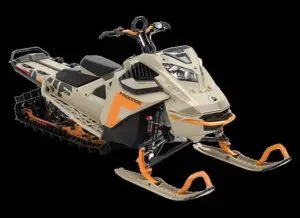
Ski-Doo Freeride is another alternative from the brand among the best snowmobile for backcountry skiing. It has been designed for conquering the backcountry and will enable skiers to reach remote areas. Its 850 E-TEC Turbo engine provides exceptional power for navigating challenging conditions and steep slopes. The REV Gen4 chassis features KYB Pro Series shocks and ensures that the rider stays in control, whether on powder or airborne. These features make it one of the best snowmobiles for backcountry skiing. Buyers must be aware that the Ski-Doo Freeride is a spring-only model, and they should plan their purchase accordingly. A non-turbo variant of the engine is also available as an option.
Yamaha Mountain Max LE 165
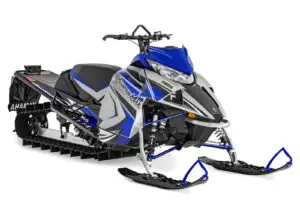
Yamaha Mountain Max LE 165 is a solid choice for enthusiasts requiring the best snowmobile for backcountry skiing. It has a powerful 2-cylinder, 2-stroke high-performance engine with a 794cc displacement capacity under its hood. The Mountain Single Beam suspension with 7” front and 15” rear travel ensures a smooth ride on deep snow and steep slopes. Riders will find the machine easy to maneuver and the handling accurate. Yamaha Mountain Max LE 165 has a 165” PowerClaw Track with 3” lugs in a 3.5” pitch configuration to provide maximum grip and traction even in the deepest powder. It makes the sled one of the best snowmobiles for backcountry skiing.
Yamaha SXVenom Mountain
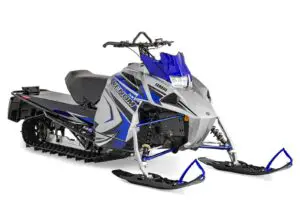
Yamaha SXVenom Mountain is a relatively affordable sled out of the best snowmobile for backcountry skiing. It packs adequate performance to satisfy experienced snowmobilers without overwhelming new riders at the same time. The machine features a 2-stroke, 397cc engine coupled with an alloy chassis, allowing skiers to navigate the backcountry easily. Its Mountain Single Beam suspension facilitates exceptional handling even in the deepest powder. The 15 x 146 x 2” Camso Challenger track gives a sure hold to navigate unexplored territory effortlessly. All these features make Yamaha SXVenom Mountain one of the best snowmobiles for backcountry skiing. The asking price of around $8,700 enhances the attractiveness of the sled.
Important Features to Consider When Choosing the Best Snowmobile for Backcountry Skiing
Here are some important factors to consider when choosing a snowmobile suitable for backcountry skiing.
Weight
Lighter sleds will outperform heavier ones in deeper snow. The reason is the heavier a sled machine is, the deeper it sinks in the snow. They provide worse floatation, which is a significant disadvantage in deep snow. They not only get caught easily in deep snow, but it is also difficult to get them out.
Moreover, a low weight can greatly minimize fatigue, which is vital during lengthy rides. Besides, the engine accounts for a large portion of the weight of a snowmobile. A smaller engine will save pounds and also make the machine more effective in deep snow. With this in mind, 2-stroke engines are more lightweight and offer a better power-to-weight ratio than 4-stroke engines. This renders them a superior choice for deep snow machines.
If you intend to ride your sled off-trail frequently, particularly in the mountains, you must pick one of the more powerful versions. Steep hills and deep powder aren’t appropriate for beginners or underpowered sleds! Therefore, you should pay double attention to weights when intending to find the best snowmobile for backcountry skiing.
Track Length
Longer tracks are preferred for deeper snow. They will increase your surface area, allowing better floatation and traction.
Consider it similar to a snowshoe versus a snow boot. The snowshoe is substantially longer and allows you to remain above the snow without sinking.
If you see the phrase “long track” snowmobile, it means that the machine you’re looking at works well in deep snow. Generally, track lengths of 145 inches or more will do great in deep snow and will provide the best snowmobile for backcountry skiing.
Skis
The skis on a deep snow snowmobile are also an important feature to consider. Similar to track length, a greater surface area will provide you with greater float as well as a harder bite. Moreover, the first rule of off-trail riding, as they say, is to keep your snowmobile from sinking into deep snow. Therefore, many powder-focused snowmobiles will feature skis that are longer and wider than trail sleds.
When it comes to riding in deep snow, the exact width and length of your skis are a bit of an individual rider choice, though there are certain benefits of going bigger.
Additionally, ski stance is usually an overlooked dimension of a sled. Mountain sleds often have a narrower ski stance for increased agility, but if it’s too narrow, the sled can tip over.
There are also specific “hill-climb snowmobiles” on the market that have a wider front-end ski stance for added stability.
Best Snowmobile for Backcountry Skiing Driving Tips
Backcountry snowmobiling provides greater freedom and access to terrain such as mountain ranges but at a higher risk. With greater liberty comes higher exposure to extreme weather and hazardous terrain. If more independence, wildness, and pushing your snowmobile expertise to the limit seem appealing, you’re probably ready to explore the world of backcountry snowmobiling. However, deep snow riding necessitates a certain skill set and knowledge. Here are some driving tips to keep in mind before embarking on a backcountry snowmobile journey with the best snowmobile for backcountry skiing.
Practice Safety
Every rider should know that these vehicles can be dangerous and so can the winter conditions in general.
Always wear a helmet and appropriate cold-weather clothing to keep you warm and comfortable. A helmet is an important piece of safety equipment that can save your life. To avoid hypothermia and frostbite, adequate clothing is vital.
It is usually preferable to ride with others and never go out alone, particularly if you’re new to snowmobiling. Tipping a sled or getting lost is possible, and another individual gives additional security.
Before you go, you should also educate yourself on avalanche safety and other basic winter safety techniques. Equip yourself with the important accessories and gear for digging out if you get caught in a slide.
Balance and Comfort
Hopping on the sled is the first step. There is not much about it. Grab the handlebars and ensure that you are not sitting too forward or too backward. This should all be done before starting the engine. Make all the adjustments regarding clothing or any points of discomfort before driving, as adjusting things on speed would be difficult.
Good balance is also vital, and you should practice finding your center before hitting the throttle. Besides, you have to stand whenever you can. This requires bending your knees and relaxing your arms. This is necessary as driving in powder demands continuous weight shifting from side to side. Furthermore, practice sitting back on the sled to keep the front end from getting stuck when encountering deep snow.
Look Forward and Plan
Another crucial tip is to keep your head up, look ahead, and plan the path. This is critical because, unlike trail riding, you must now be prepared for rapid changes in terrain, rocks, trees, and so on.
You should plan your path around these difficulties before you reach them. You can’t adjust to changing conditions if you don’t know where you want to go!
The best practice is to pause and plan for 5-10 seconds ahead of you. In this manner, you can always prepare for new changes and your sled’s needs.
Learn to Maneuver
Cornering in deep snow is similar to jet ski carving. If your sled starts to tip over, adjust your weight to balance it out. Since conditions can change quickly, you must constantly adjust your weight.
If you want to improve your balance when making swift turns in heavy snow, try placing both your feet on one side of the sled.
The depth of your sled in the snow is always determined by how quickly you spin. Remember that the sharper your turns are, the more aerobics you must perform.
Be cautious because riding your snowmobile hard can cause it to wear out.
Learn to Stop
You must also learn how to stop your sled in deep snow. This is because if you stop your machine in powder, it will sink in seconds!
That is why you must always come to a halt on hard-packed surfaces. It could be tricky if you just carved an untouched area and wish to stop there. If this occurs, simply make a full circle and stop on your own track. Similarly, it is advised not to stop on an incline. However, if it’s inevitable, always point the snowmobile downhill to make the start smoother.
Maintain Your Momentum
The key to riding your sled in and out of the trail properly is to maintain constant momentum.
This is due to the fact that momentum essentially maintains the machine on top of power. This implies that going too slowly can cause your snowmobile to sink.
Also, avoid extremely violent accelerations from low speeds and on steep slopes, as these can easily spin your route.
If you think you have applied excessive throttle and the sled is sinking, simply release the throttle. This approach frequently aids in returning the sled to the snow’s surface. Once it’s back on the surface, simply pump the throttle and keep going.
Another method for maintaining a steady pace is to blip the throttle rather than allowing it to return to idle. This improves the responsiveness of your engine.
Learn how to Free a Stuck Snowmobile from Snow
One of the most common problems with off-trail sledding is becoming stuck in the deep snow.
Even professional snowmobilers, believe it or not, get trapped in deep snow sometimes. This means that if you ride in powder, you should expect to get stuck at some point.
That is why you must first learn how to free your stuck sled. Since you won’t be able to move a 500 lbs. snowmobile out of the hole, your only option is to ride it out.
In short, you must clear the snow beneath the front of the sled. Then, walk on the snow in front of the sled to form an exit track.
When the track is completed, apply some throttle and carefully ride out of the hole.
Best Snowmobile for Backcountry Skiing Frequently Asked Questions (FAQ’s)
What is the best snowmobile for deep snow?
The lightweight 2-stroke sleds are undoubtedly the best snowmobiles for deep snow. These versions have extended tracks, which improve their flotation and traction characteristics.
Out of all the snowmobiles mentioned for backcountry skiing, the Ski-Doo summit earns popularity among riders for riding in deep snow. It is one of the preferred sleds in the Ski-Doo collection as it is designed explicitly for deeper snow and can easily gobble up the wilderness.
The machine is fast, nimble, and powerful and is pretty much exactly what the best snowmobile for deep snow calls for.
What are three of the best tips you can give a first-time snowmobile owner?
The three best tips that will help you get the most out of your ride as a first-time snowmobile owner are:
1. Go with Experienced Riders or Guided Tours
Snowmobiling is not a solitary sport; it is a group endeavor (and the accompanying camaraderie is one of the reasons people enjoy it!). People with more snowmobile experience prefer self-guided tours sometimes. They can go at their own pace, stop whenever they want, and explore remote regions in whatever way they desire. If you’re new to riding, a guided tour or riding with other experienced riders is probably your best bet. They will not only offer their snowmobiling knowledge and help out if anything goes wrong but also recommend must-see sights, historic landmarks, and wildlife along the way.
It is essential that you notify a trustworthy friend or family member of your plans before embarking on the journey. This will keep you from becoming stranded, and if something goes wrong, someone will have information about where to look for you.
2. Keep Exploring
Don’t be astonished if you become addicted to snowmobile after your first ride. It is that entertaining! And, as you ride more, you’ll get more at ease with faster speeds, altering snow conditions, and various terrains.
3. Be Alert of your Surroundings.
Snowmobiling necessitates a high level of attention. If you become sidetracked, you will most likely miss out on appreciating the surroundings. Additionally, you may miss a roadblock and hurt yourself or others as a result.
You should always be aware of your surroundings. Pay attention to the terrain as well as the weather. Always keep an eye out for any threats both ahead and around you. If you feel comfortable doing so, you may wish to look behind every now and again to ensure that everyone in your team is safe.
What is the best snowmobile for the mountains?
Mountain snowmobiles are deep snow sleds that are purpose-built for use in steep terrain and deep snow. They have fantastic maneuverability and hill-climbing capabilities. They are basically sportscars of the slopes – lightweight, nimble, and sleek.
Mountain snowmobiles have powerful engines and large powder-gripping lugs to propel the vehicle on powdery snow and handle large variations in elevation.
Riding experts agree that the best snowmobiles for the mountain are manufactured by the “Big Four” brands: Ski-Doo, Polaris, Arctic Cat, and Yamaha.
The Polaris PRO RMK, Ski-Doo Summit X, Arctic Cat Alpha One, Yamaha Mountain MAX, and SXVenom Mountain are prime examples of the best-performance mountain snowmobiles.
All these best mountain snowmobiles are narrow and light, so you can maneuver tight trails and ride aggressively. Their main benefit is that they can go almost anywhere, allowing you to explore distant locations!
What is the most reliable snowmobile ever made?
Selecting the most reliable snowmobile depends on various factors. First, which type of snowmobile do you require, and secondly, where you will ride it mainly.
Many expert snowmobilers think that Yamaha snowmobiles are the most reliable, which is likely due to the unique Japanese technology they employ, in which each vehicle is individually inspected before it is sold.
You could be thinking, if Yamaha sleds are such excellent quality, why do they only have a 5% market share? The Japanese organization does not place a high value on marketing and advertising their products since they are more concerned with the quality of whatever they make.
Their Yamaha Sidewinder MTX is the best snowmobile if reliability is the chief factor. The manufacturer introduced this in 2002 and has made numerous improvements since then to increase the performance and weight of the four-stroke engine. It is a beast on the trail and is considered among the most reliable workhorses ever made.
Furthermore, Arctic Cat also scores major points when it comes to reliability. The Arctic Cat Alpha One offers a reliably smooth riding performance thanks to an aluminum beam in the center, which allows the track to bend as you ride.
What is the best snowmobile track length for mountains?
You should aim for 162-175 inches. The 165 inches is the preferred length among expert mountain snowmobilers as it serves as the middle ground between being maneuverable and still maintaining good floatation and traction.
The best snowmobile track length is one that is appropriate for both your sled and your demands. Shorter tracks, on average, give better handling and demand less engine power. Longer tracks, on the other hand, offer better flotation, comfort, and stability. That is why mountain sleds usually have longer tracks. Longer track length performs better in deep snow and reduces the likelihood of getting stuck in it. But how much of a track length would be suitable for a mountain snowmobile?
